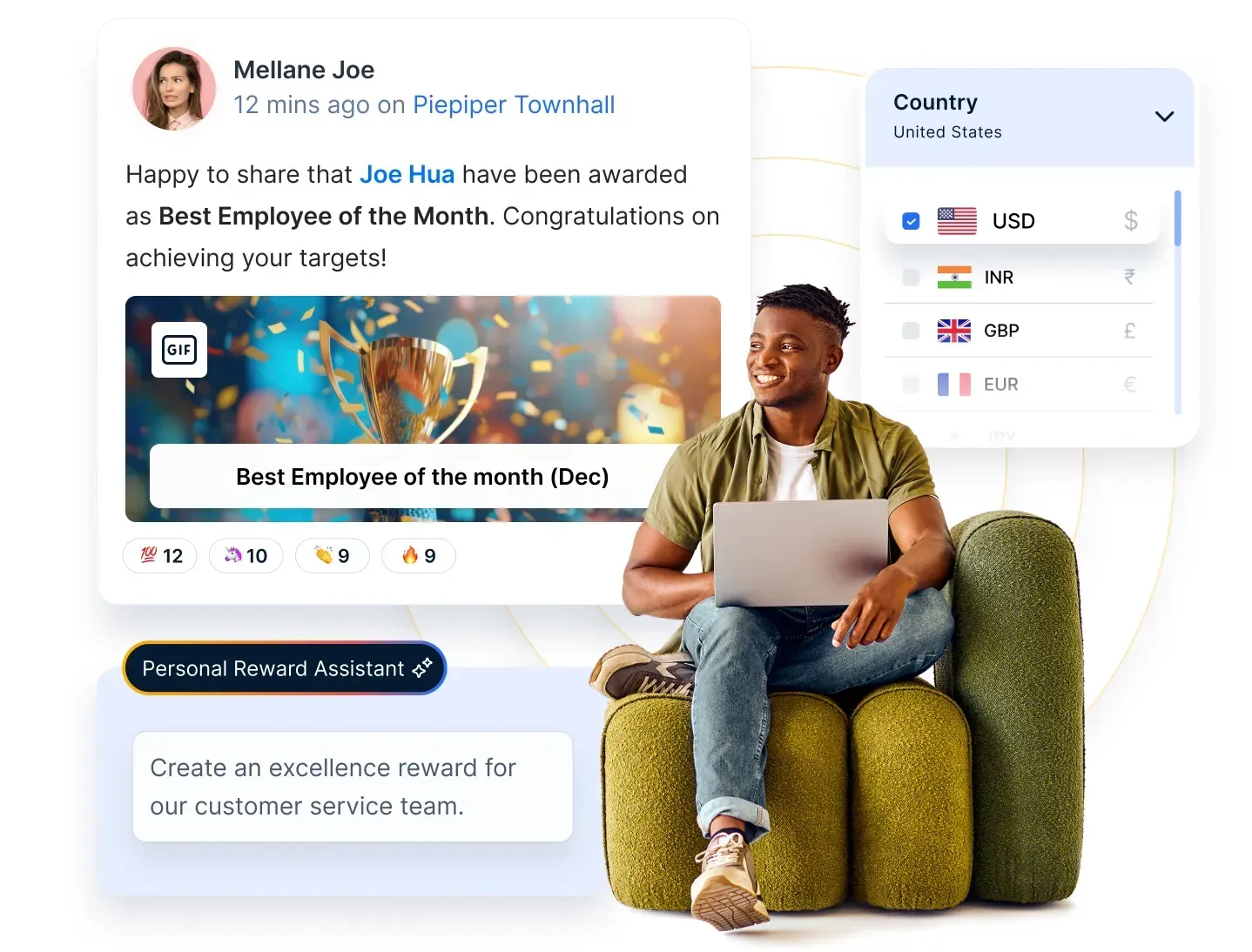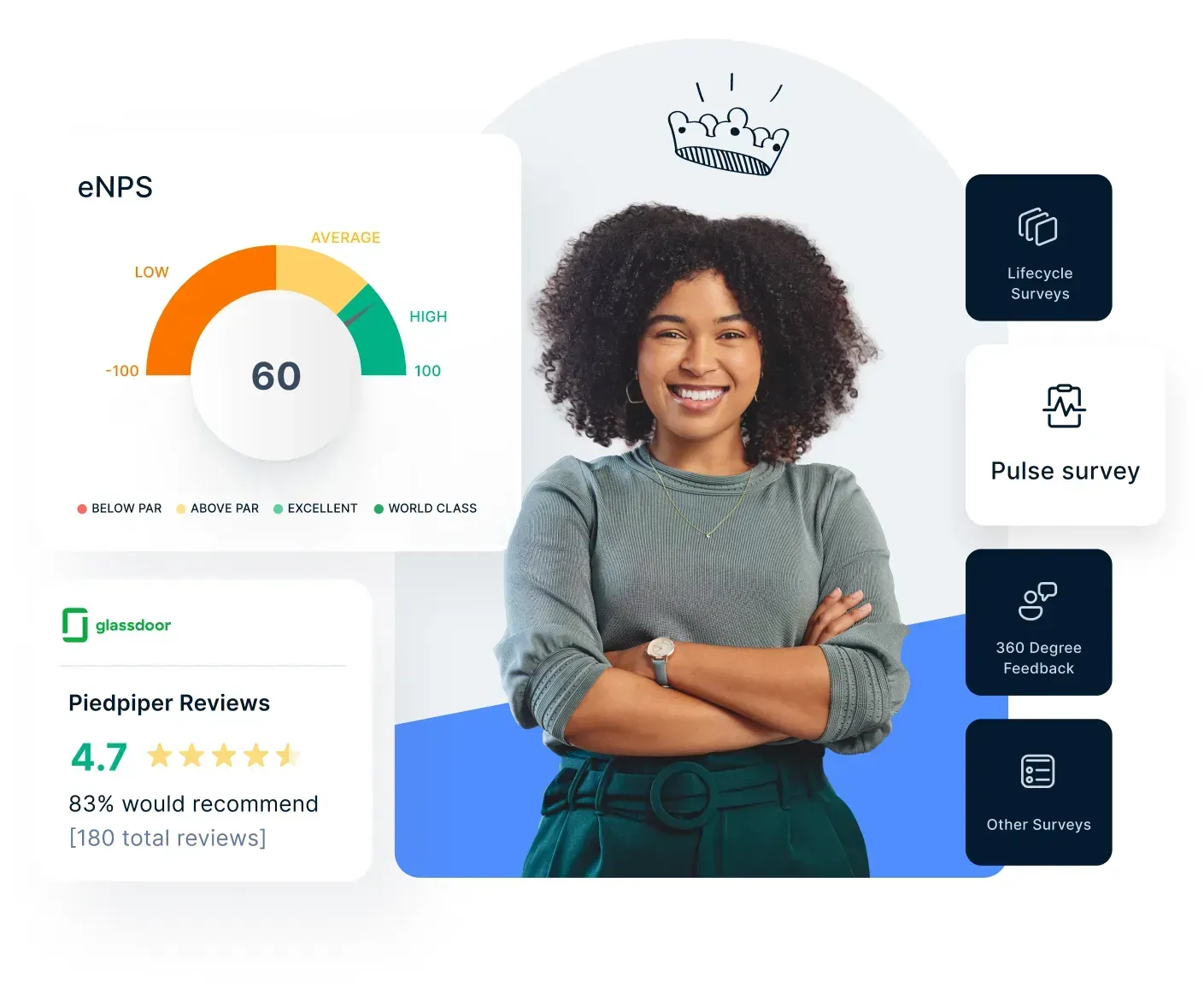Wie Sie die Mitarbeiterbindung verbessern können: 13 kreative Wege zur Mitarbeiterbindung
Finden Sie heraus, wie Sie die Mitarbeiterbindung verbessern können, indem Sie die wichtigsten Herausforderungen angehen, das Engagement fördern und ein Arbeitsumfeld schaffen, das den Mitarbeitern gefällt.
Auf dieser Seite
Einer der größten Schmerzpunkte für Unternehmen ist die Verbesserung der Mitarbeiterbindung. Laut den Daten des Bureau of Labor Statisticshaben allein zwischen Juli und November 2022 mehr als 4 Millionen Amerikaner ihren Arbeitsplatz freiwillig verlassen.
Um diese Studie zu untermauern, Gartner dass der Unternehmenssektor in den kommenden Jahren eine Fluktuationsrate von bis zu 24 % verzeichnen könnte, was Unternehmen dazu veranlasst, bessere Strategien zur Mitarbeiterbindung zu entwickeln.
Die Mitarbeiter gelten als das größte Kapital eines Unternehmens, und an zweiter Stelle stehen die Kunden. Wenn Sie sorgfältig mit Ihren Mitarbeitern umgehen, werden diese dieses Gefühl auch an Ihre Kunden weitergeben, wodurch Sie sich vom Rest des Marktes abheben. Der Schlüssel dazu ist das Engagement der Mitarbeiter.
A Gallup-Studie hat gezeigt, dass Unternehmen mit hoch engagierten Mitarbeitern eine um 21 % höhere Rentabilität verzeichnen können, was die Umsetzung von getesteten Strategien zur Mitarbeiterbindung erforderlich macht. Nehmen Sie große Marken wie Facebook, Amazon, TATA und Google als Beispiel. Diese Unternehmen, um nur einige zu nennen, haben eines gemeinsam: Sie stellen Talente ein und halten sie.
In der heutigen wettbewerbsorientierten Welt fühlen sich hochqualifizierte Arbeitnehmer möglicherweise gezwungen, eine andere Stelle anzunehmen, wenn sie ein besseres Angebot erhalten. Ein Mitarbeiter, der sich nicht engagiert und respektiert fühlt oder in Ihrem Unternehmen nicht vorankommt, wird sich nach anderen, besseren Möglichkeiten umsehen.
Sie möchten also die Personalfluktuation verringern und die Produktivität steigern. In diesem Fall sollte die Entwicklung einer wirksamen Strategie zur Mitarbeiterbindung ganz oben auf Ihrer Aufgabenliste stehen.
Was bedeutet Mitarbeiterbindung?
Unter Mitarbeiterbindung versteht man die allgemeinen Bemühungen eines Unternehmens, seine Mitarbeiter am Verlassen des Unternehmens zu hindern. Im weiteren Sinne geht es darum, ein Umfeld zu schaffen, in dem die Mitarbeiter die drei Grundpfeiler der Mitarbeiterbindung erfahren: Respekt, Belohnung und Anerkennung.
Programme zur Mitarbeiterbindung können unterschiedlich sein, je nachdem, woran es dem Unternehmen mangelt. Hier sind einige Beispiele:
- Einrichtung von Peer-to-Peer-Selbsthilfegruppen oder kostenlosen Beratungsangeboten
- Integration von AI-Technologie wie KI-Bildgeneratoren, AI Diashow-Erstelleroder Texterstellungssoftware zur Automatisierung von Aufgaben und Erleichterung der Arbeit
- Flexible und dezentrale Arbeitsformen
- Umgekehrtes Mentoring, bei dem Mitarbeiter ihren Vorgesetzten Feedback geben
Bauen Sie diese Programme auf den grundlegenden Werten der Mitarbeiterbindung auf, und genießen Sie den Hauptvorteil einer besseren Mitarbeitererfahrung - die Rekrutierung von Spitzentalenten, die bei Ihnen bleiben.
Inzwischen gibt es einen Gallagher-Bericht der den Zustand der Mitarbeiterbindung im Jahr 2024 vorhersagt. Darin heißt es, dass 57 % der Unternehmen einen Anstieg der Mitarbeiterzahl erwarten. Die Mitarbeiterbindung hat nach wie vor oberste betriebliche Priorität, was deutlich macht, dass die Unternehmen ihre Bemühungen ausweiten müssen, um zu verhindern, dass Mitarbeiter das Unternehmen verlassen.
Herausforderungen bei der Mitarbeiterbindung
Die Bindung von Mitarbeitern an das Unternehmen geht über das bloße Angebot eines Gehaltsschecks hinaus. Unternehmen müssen die wichtigsten Herausforderungen angehen, die sich auf Arbeitszufriedenheit, Engagement und langfristiges Engagement auswirken. Durch das Erkennen dieser Hindernisse und die Umsetzung kreativer Methoden zur Mitarbeiterbindung können Unternehmen einen Arbeitsplatz schaffen, an dem sich die Mitarbeiter wertgeschätzt fühlen, motiviert sind und gerne bleiben möchten.
1. Fehlende berufliche Entwicklungsmöglichkeiten
Mitarbeiter verlassen oft das Unternehmen, wenn sie das Gefühl haben, in der gleichen Position festzustecken, ohne klare Aufstiegsmöglichkeiten zu haben. Unternehmen, die keine Schulungen, Mentorenprogramme oder Beförderungen anbieten, riskieren, Spitzenkräfte an die Konkurrenz zu verlieren. Berufliche Weiterbildungsprogramme und Workshops zum Erwerb von Fähigkeiten sind kreative Wege, um Mitarbeiter zu halten und zu binden.
2. Unzureichende Vergütung und Sozialleistungen
Wettbewerbsfähige Gehälter und Sozialleistungen sind entscheidend für die Mitarbeiterbindung. Wenn sich Mitarbeiter unterbezahlt fühlen oder ihre Leistungen nicht dem Branchenstandard entsprechen, werden sie sich eher nach anderen Beschäftigungsmöglichkeiten umsehen. Leistungsabhängige Prämien, Wellness-Programme und individuelle Vergünstigungen können kreative Wege sein, um Mitarbeiter zu binden und gleichzeitig die Arbeitszufriedenheit zu verbessern.
3. Schlechte Work-Life-Balance
Arbeitnehmer, die Schwierigkeiten haben, ein Gleichgewicht zwischen Arbeit und Privatleben zu finden, leiden häufig unter Burnout. Starre Zeitpläne, übermäßige Arbeitsbelastung und unrealistische Erwartungen führen zu Unzufriedenheit und erhöhter Fluktuation. Die Einführung flexibler Arbeitsregelungen, die Möglichkeit der Fernarbeit und zusätzlicher bezahlter Urlaub können kreative Wege sein, um Mitarbeiter zu halten und ihr allgemeines Wohlbefinden zu verbessern.
4. Fehlende Anerkennung und Anreize
Die Mitarbeiter müssen das Gefühl haben, dass ihre Beiträge geschätzt und gewürdigt werden. Wenn Unternehmen es versäumen, Anstrengungen anzuerkennen oder Leistungen zu belohnen, sinken Motivation und Loyalität. Die Einführung von Anreizprogrammen, Plattformen zur Anerkennung von Mitarbeitern und nicht-monetären Belohnungen sind kreative Wege, um Mitarbeiter zu binden und eine Kultur der Wertschätzung zu fördern.
5. Schwache Unternehmenskultur und Engagement
Ein giftiges Arbeitsumfeld, schlechte Führung und mangelnde Zusammenarbeit im Team können Mitarbeiter vertreiben. Mitarbeiter, die sich nicht zugehörig fühlen, bleiben dem Unternehmen seltener treu. Die Förderung einer offenen Kommunikation, die Förderung von Inklusion und die Organisation von teambildenden Maßnahmen sind kreative Wege, um Mitarbeiter zu halten und die Arbeitsplatzkultur zu stärken.
Wie berechnet man die Mitarbeiterbindungsrate?
Die Personalabteilung sollte bei der Erörterung von Strategien zur Mitarbeiterbindung über spezifische Maßnahmen zur Verfolgung von Statistiken zur Mitarbeiterbindung verfügen. Wenn Sie solche Statistiken verfolgen, werden Sie wissen, welche Initiativen zur Senkung der Mitarbeiterbindungsrate ergriffen werden können.
Die Berechnung der Mitarbeiterbindungsrate ist einfach: Teilen Sie die Gesamtzahl der Mitarbeiter, die während eines Zeitraums ausgeschieden sind, durch die Gesamtzahl der Mitarbeiter am Ende des Zeitraums, um den Prozentsatz zu erhalten.
Zeitraum: 3. Quartal
Gesamtzahl der Beschäftigten zu Beginn von Q3 = 34
Gesamtzahl der Mitarbeiter, die in Q3 ausgeschieden sind: 4
Berechnung: 34-4 =30
Mitarbeiterbindungsrate = Gesamtzahl der Mitarbeiter, die während eines Zeitraums ausgeschieden sind
Gesamtzahl der Beschäftigten am Ende eines Zeitraums
Mitarbeiterbindungsrate = 30 / 34 = 88%
Untersuchungen des Center for American Progress zeigen, dass die Kosten für den Ersatz hochqualifizierter Mitarbeiter/Führungskräfte leicht das Doppelte ihres Jahresgehalts übersteigen können. Das Ziel jedes Unternehmens ist es, talentierte Mitarbeiter einzustellen und sie dazu zu bringen, länger zu bleiben.
Die Mitarbeiterbindung ist keine leichte Aufgabe. Eine aktuelle Studie von Willis Towers Watson besagt, dass mehr als die Hälfte der Unternehmen weltweit über Schwierigkeiten bei der Bindung einiger ihrer wertvollsten Mitarbeiter berichten.

Binden Sie Ihre besten Talente mit aussagekräftigen Anerkennungen
Mitarbeiterbindung beginnt mit Wertschätzung. Nutzen Sie Empuls , um eine Kultur der kontinuierlichen Anerkennung, Belohnung und des Engagements zu schaffen, die Mitarbeiter motiviert und engagiert hält.
Wie man die Mitarbeiterbindung verbessert: Die 13 wirksamsten Strategien
Im Folgenden finden Sie einige Tipps, wie Sie die Mitarbeiterbindung verbessern können. Einige dieser Tipps sind Ihnen vielleicht schon bekannt, andere wiederum sind neu für Sie, aber unterm Strich helfen Ihnen all diese Tipps, Ihre Leistungsträger langfristig an sich zu binden.
1. Analysieren Sie, warum Mitarbeiter gehen
Wenn Sie nicht wissen, warum Mitarbeiter Ihr Unternehmen verlassen, können Sie keine wirksame Strategie entwickeln, um sie zum Bleiben zu bewegen.
Überprüfen Sie zunächst die durchschnittliche Fluktuationsrate in Ihrer Branche - ist Ihre Fluktuationsrate höher als der Durchschnitt?
Die Durchführung von Austrittsgesprächen mit ausscheidenden Mitarbeitern kann Ihnen Aufschluss über die wahren Gründe geben, aus denen die Mitarbeiter gehen.
Schließlich sind sie eher bereit, ehrlich zu sein, wenn sie das Unternehmen verlassen, und wenn Sie sie nicht selbst fragen, könnten sie es der Welt in einer negativen Bewertung auf Glassdoor oder einer anderen Website mitteilen.
Schauen Sie sich die Muster an, die Sie erkennen, sobald Sie begonnen haben, Ihre Daten zu sammeln. Erhalten Sie von mehreren Mitarbeitern Rückmeldungen zu Fragen der Vereinbarkeit von Beruf und Privatleben, zu Problemen mit dem Vorgesetzten, zur Arbeitsplatzkultur, zu stockender beruflicher Entwicklung oder zu anderen Themen?
Was steht Ihrer Strategie zur Mitarbeiterbindung im Weg? Sie können ein Problem erst dann beheben, wenn Sie es identifizieren können.
2. Überprüfen Sie Ihre Einstellungsstrategie
Alles beginnt mit der Einstellung. Die Menschen, die Sie verlassen, sind die Menschen, die Sie einmal eingestellt haben. Werfen Sie also einen genaueren Blick auf Ihr EinstellungsprozessDazu gehören die Stellenanforderungen, die Stellenbeschreibung, die Vorstellungsgespräche, die Vergütung und die Sozialleistungen sowie die Aufgaben und Zuständigkeiten.
Und stellen Sie fest, dass viele Mitarbeiter einige Monate nach ihrer Einstellung kündigen, weil die Stelle nicht ihren Vorstellungen entspricht?
Ihre Stellenbeschreibungen sollten einen ehrlichen Einblick in Ihre Unternehmenskultur und eine detaillierte und genaue Darstellung der Aufgabenbereiche bieten.
Die Mitarbeiter sollten nicht von den grundlegenden Aspekten des Jobs überrascht werden, nachdem sie ihn angetreten haben - das bedeutet, dass Sie im Einstellungsprozess etwas anpassen müssen, damit Sie von Anfang an die richtigen Leute einstellen und die richtigen Erwartungen wecken.
3. Optimieren Sie das Onboarding von Mitarbeitern
Der erste Tag an einem neuen Arbeitsplatz ähnelt oft der Erfahrung, die wir am ersten Schultag gemacht haben - die Nervosität, die Aufregung, neue Leute zu treffen, neue Dinge zu lernen usw.
Während es für die neuen Mitarbeiter eine Herausforderung ist, sich mit der neuen Umgebung, den Menschen, den Verfahren, den Aufgaben usw. vertraut zu machen, ist es für die Führungskräfte eine ebenso große Herausforderung.
Es liegt in der Verantwortung des Managers, den neuen Mitarbeiter auf Erfolgskurs zu bringen, indem er ihm von Anfang an das Gefühl vermittelt, dass er sich im Unternehmen und im Team wohlfühlt (und zwar noch vor seinem ersten Arbeitstag!).
Ein intelligenter, gut durchdachter, individueller Plan für jeden neu eingestellten Mitarbeiter kann viel bewirken. Stellen Sie sicher, dass die Mitarbeiter nicht nur über ihre Aufgaben und Zuständigkeiten informiert werden, sondern auch über die Unternehmenskultur und darüber, wie sie sich jeden Tag weiterentwickeln können.
Erstellen Sie Pläne und Ziele für die erste Woche, den ersten Monat, das erste Quartal usw., damit die Mitarbeiter wissen, was von ihnen erwartet wird.
Gesten wie eine Ankündigung im Intranet-Portal, die Vorstellung der neuen Mitarbeiter, die Zusammenstellung eines Buddy oder eines Mentors, der ihnen hilft, die ersten Tage zu überstehen, können viel bewirken.
Kurz gesagt, die Onboarding-Erlebnis für Mitarbeiter sollte genauso gut geplant und durchdacht sein wie das Onboarding von Kunden.
Neu eingestellte Mitarbeiter nehmen an der "NooglerOrientierung" teil, die eine umfassende Schulung zu den Werten des Unternehmens, den Instrumenten und den arbeitsplatzspezifischen Aufgaben umfasst. Untersuchungen zeigen, dass Unternehmen mit einem starken Onboarding-Prozess die Bindung neuer Mitarbeiter um 82% und die Produktivität um über 60%.
4. In die Mitarbeiterentwicklung investieren
Eine Investition in Wissen bringt immer die besten Zinsen". - Benjamin Franklin
Eine der einfachsten Möglichkeiten, die Personalfluktuation zu verringern, besteht darin, gute Aufstiegsmöglichkeiten zu bieten. Die Hauptgrund, warum Mitarbeiter ein Unternehmen verlassen ist, dass sie keine erfüllende langfristige Karriere vor sich sehen.
Wenn Sie keine regelmäßigen beruflichen Entwicklungsmöglichkeiten und kein faires Beförderungssystem anbieten, werden die Mitarbeiter frustriert sein und sich nach anderen Stellen umsehen.
Das bedeutet nicht, dass Sie jeden Mitarbeiter jedes Jahr befördern müssen - das ist nicht sinnvoll, und Ihre Mitarbeiter wissen das.
Aber sie wollen wissen, wie ihr Karriereweg aussehen könnte, sie wollen regelmäßig mit ihren Vorgesetzten über ihre berufliche Entwicklung sprechen und wissen, dass die Aufstiegsmöglichkeiten klar dargelegt und gerecht verteilt sind.
Mitarbeiter aufgrund unzureichender Lernmöglichkeiten zu verlieren, ist wahrscheinlich eine der schlimmsten Arten, sein Talent zu verlieren. Dies sind die neugierigen Menschen - neugierig auf neue Technologien, Techniken, Prozesse usw. - und neugierige Menschen sind oft großartige Mitarbeiter.
Diese Mitarbeiter stellen sich jeder neuen Herausforderung und denken sich kreative Lösungen aus.
Wenn Sie Ihre Mitarbeiter ermutigen, sich ständig weiterzubilden und sich mit den neuesten Trends und Technologien auf dem Markt vertraut zu machen, werden Sie sie davon abhalten, das Unternehmen zu verlassen.
Investieren Sie vorrangig in die berufliche Weiterbildung und Entwicklung Ihrer Mitarbeiter, indem Sie spezielle Mittel für Online-Kurse bereitstellen, bei Bedarf Studiengebühren erstatten, an Branchenveranstaltungen, Webinaren und Konferenzen teilnehmen usw.
5. Auswahl der richtigen Manager und Coaching dieser Manager
Wir alle kennen den bekannten Satz "Mitarbeiter verlassen Manager, nicht Unternehmen". Führungskräfte haben einen großen Einfluss auf Mitarbeiter und Teams.
Sie haben einen direkten Einfluss darauf, wie engagiert und motiviert die Mitarbeiter sind - und damit auch darauf, wie lange sie wahrscheinlich in einem Unternehmen arbeiten werden. Aber was ist es, das die Mitarbeiter an ihren Führungskräften nicht mögen?
Von Bevorzugung über unangemessene Annäherungsversuche bis hin zu unzureichender Kommunikation, Mikromanagementnicht genug wertschätzen, dem Team nicht genug zuhören, nicht entscheidungsfreudig sein, nicht genug Lernmöglichkeiten bieten usw., kann extrem demotivierend sein und die Mitarbeiter dazu bringen, das Unternehmen zu verlassen.
Eine der besten Möglichkeiten, dies zu vermeiden und eine gute Beziehung zwischen Führungskraft und Mitarbeiter ist es, die Führungskräfte mit der richtigen Art von Befähigungsschulung, Lernmaterial usw. auszustatten.
Die Bereitstellung ausreichender Mittel zur freien Verfügung für die Belohnung von Teammitgliedern und das Knüpfen von Kontakten mit dem Team bei Mittag- und Abendessen wird ebenfalls dazu beitragen, das Eis zu brechen. Der Einsatz von technischen Plattformen für effektives persönliches Feedback und die Nutzung von sozialen Intranet-Plattformen, um mit dem Team in Kontakt zu treten und zusammenzuarbeiten können ebenfalls einen großen Beitrag zum Aufbau leistungsstarker Teams leisten.
Die sorgfältige Auswahl Ihrer Führungskräfte und die gründliche Schulung ihrer Managementfähigkeiten tragen zum Erfolg Ihrer Vorgesetzten und zur Zufriedenheit Ihrer Mitarbeiter bei.
6. Förderung der Sozialisierung am Arbeitsplatz
Wenn ich mit Menschen spreche, die ihre Arbeit lieben und bei der Arbeit lebendige Freundschaften pflegen, sprechen sie immer davon, dass ihre Arbeitsgruppe wie eine Familie ist. - Tom Rath
Wir neigen dazu, einen größeren Teil unserer Zeit am Arbeitsplatz/bei der Arbeit zu verbringen als mit unserer Familie. Meinen Sie nicht, dass die Förderung von Freundschaften am Arbeitsplatz dazu beiträgt, ein starkes, verbundenes und glückliches Unternehmen aufzubauen?
Freundschaften am Arbeitsplatz sorgen dafür, dass der Weg zur Arbeit weniger obligatorisch ist und mehr Spaß macht und man sich darauf freut.
Soziale Kontakte am Arbeitsplatz gehen weit über einen Drink mit einem Kollegen am Freitagabend oder einen gelegentlichen Teambuilding-Tag hinaus.
Der Aufbau von "mitfühlenden" und "bedeutungsvollen" Bindungen zu den Kollegen kann einen großen Beitrag zu einer glücklichen, zufriedenen Belegschaft leisten.
Bieten Sie Ihren Mitarbeitern mehrere Möglichkeiten, das Eis zu brechen und Kontakte zu knüpfen - sei es durch regelmäßige Firmenveranstaltungen und -feiern oder durch leistungsfähige Kommunikationsplattformen.
Soziale Kontakte am Arbeitsplatz tragen wesentlich zur Mitarbeiterbindung bei.
7. Schaffung von Vertrauen durch transparente Kommunikation
Das größte Problem der Kommunikation ist die Illusion, dass sie stattgefunden hat. - George Bernard Shaw
Gute Kommunikation ist wie ein gutes Tennisspiel - sie besteht aus guten Volleys.
Die Kommunikation ist nicht mehr so wie vor Jahrzehnten, als die Geschäftsleitung Memos verschickte oder Aushänge machte, ohne dass die Mitarbeiter die Möglichkeit hatten, ihre Ansichten und Meinungen zu äußern.
In der heutigen schnelllebigen Welt erwarten die Mitarbeiter, dass sie über die Entwicklungen in jedem Unternehmen auf dem Laufenden bleiben und ihre Gedanken und Meinungen dazu äußern können.
Die innovativsten und erfolgreichsten Unternehmen warten nicht auf unzufriedene Mitarbeiter mit geringer Produktivität. Dennoch investieren sie in eine Technologieplattform, die Mitarbeiter miteinander verbindet - unabhängig davon, von wo aus sie arbeiten, in welchem Teil der Welt oder über welches Gerät sie verbunden sind.
Eine digitale Kommunikations- und Kollaborationsplattform wie ein Intranet bietet Ihnen die Möglichkeit, kreative Wege für die Kommunikation zu finden, z. B. Kurznachrichten von Führungskräften, kurze Gespräche zwischen Managern und Teammitgliedern, Ankündigungen der Personalabteilung oder Meinungsumfragen.
Diese Plattformen helfen den Führungskräften, mit allen Mitarbeitern in Kontakt zu bleiben, und geben den Mitarbeitern reichlich Gelegenheit, ihre Ansichten, Ideen, Fragen und Bedenken mitzuteilen. Dies vermittelt die klare Botschaft, dass die Stimme der Mitarbeiter für den Erfolg des Unternehmens von entscheidender Bedeutung ist - und erhöht so das Engagement und die Mitarbeiterbindung.
8. Dankbarkeit und Anerkennung zeigen
Erkennen Sie Menschen an und bestätigen Sie sie, wenn sie zu Ihrer gemeinsamen Mission beitragen. Wenn Sie dies tun, werden Sie ihre Ziele und ihr Potenzial wecken. - Mike Byam
Eine einfache Maßnahme, die die Fluktuation erheblich verringert, ist die Anerkennung und der Dank an die Mitarbeiter für ihre harte Arbeit.
Strategien zur Verringerung der Mitarbeiterfluktuation müssen nicht immer kostspielig und umfangreich sein - sie können so einfach sein wie die Feststellung, dass jemand hervorragende Arbeit geleistet hat, und die Mitteilung, warum man sein Engagement und seine harte Arbeit schätzt.
Dies kann durch die Einführung eines formellen Anerkennungsprogramms geschehen. Aber es ist wichtig, auch die kleinen Gesten nicht zu vernachlässigen. Mitarbeiter, die sich nicht angemessen anerkannt fühlen, sind doppelt so wahrscheinlich, dass sie im nächsten Jahr kündigen - was sich erheblich auf Ihre Fluktuationsrate auswirkt.
Und 65 % der Mitarbeiter geben an, dass sie im letzten Jahr keine Form der Anerkennung für gute Arbeit erhalten haben.
Niemandem gefällt es nicht, wenn man ihm sagt, wie gut er seine Arbeit gemacht hat. Wertschätzung ist etwas, das jeder zu schätzen weiß!
Aus diesem Grund Belohnungen und Anerkennungen einen großen Einfluss darauf, wie motiviert und engagiert die Mitarbeiter sind und wie lange sie für das Unternehmen arbeiten werden. Sie vermitteln den Mitarbeitern das Gefühl, dass das Unternehmen ihre Arbeit schätzt und respektiert.
Und nicht nur das: Sie hilft den Mitarbeitern, sich auf ihre täglichen Aktivitäten zu konzentrieren und einen Sinn darin zu sehen. So viel zur Wirkung von Belohnungen und Anerkennung. Untersuchungen von Bersin & Associates haben gezeigt, dass Unternehmen mit hochwirksamen Anerkennungsprogrammen, die das Engagement der Mitarbeiter verbessern eine um 31 % niedrigere freiwillige Fluktuation aufweisen.
Machen Sie es sich zur Gewohnheit, Ihren Mitarbeitern zu danken, wenn sie etwas Besonderes leisten, sei es ein einfaches Dankeschön oder ein Lob bei der wöchentlichen Besprechung, eine Auszeichnung bei der jährlichen Gala oder ein Geschenkgutschein, um Ihre Wertschätzung zu zeigen.
Anerkennung ist am wirkungsvollsten, wenn sie "sozial" gemacht wird. Sei es eine Anerkennung wie eine Mitarbeiter des Monats oder eine Teamauszeichnung, Geburtstage oder Arbeitsjubiläen, Ankündigungen auf sozialen Intranetplattformen bringen die Organisation zum Feiern zusammen und heben die Moral der Mitarbeiter.
Außerdem hilft ein strukturiertes Belohnungs- und Anerkennungsprogramm einer Organisation, sich an ihren Werten und Überzeugungen auszurichten und diese zu stärken. Wer in der Organisation belohnt und anerkannt wird und warum, ist eine unmissverständliche Aussage über die wahren Werte und die Kultur der Organisation.
Eine große Anzahl erfolgreicher Unternehmen investiert auch in die Ideen und Innovationen ihrer Mitarbeiter und würdigt diese. Die Investition in eine formelle Plattform kann auch dabei helfen, den Mitarbeitern zu besonderen Meilensteinen, Geburtstagen, Arbeitsjubiläen usw. Glückwünsche zu übermitteln.
9. Mitarbeiter-Feedback einholen und darauf reagieren
"Feedback ist das Frühstück der Champions". - Ken Blanchard
Es wird schwierig, Mitarbeiter zu halten, wenn man keine Ahnung hat oder zu spät erkennt, mit welchen Herausforderungen die Mitarbeiter konfrontiert sind, wie sie das Arbeitsumfeld empfinden, ob sie besondere Unterstützung benötigen usw.
Das veraltete jährliche oder halbjährliche Feedback ist nicht mehr zielführend - vor allem nicht bei der heutigen Generation, die nicht nur ihre Meinung sofort äußern möchte, sondern auch schnelle Maßnahmen und Umsetzungen erwartet, wenn sie Feedback erhält.
Hier können regelmäßige (wöchentliche/monatliche) persönliche Feedbackgespräche und Umfragen Abhilfe schaffen. Mitarbeiter-Feedback kann ein wirksames Instrument sein um das Engagement und die Moral zu steigern.
Mitarbeiter fühlen sich gestärkt, wenn sie ermutigt werden, ihre Ideen, Gedanken und Ansichten zu den verschiedenen Vorgängen innerhalb des Teams oder der Organisation mitzuteilen.
Die Durchführung von Umfragen von Zeit zu Zeit durchzuführen, um den Puls der Organisation zu fühlen oder um Meinungen zu bestimmten Arbeitsbereichen einzuholen, kann von großem Nutzen sein.
Lebenszyklusumfragen können auch dabei helfen, die "wichtigen Momente" in verschiedenen Phasen zu messen, z. B. beim Onboarding, bei einem Rollenwechsel, bei einem Arbeitsjubiläum usw. Das Erfassen und Analysieren von Mitarbeitererfahrungen kann helfen, die Herausforderungen früher zu verstehen und somit schneller Maßnahmen zu ergreifen.
Das Sammeln von Feedback löst zwar einen Teil des Problems, macht aber erst dann einen großen Unterschied, wenn Sie auf das erhaltene Feedback hin Maßnahmen ergreifen.
Rechtzeitiges Handeln und die Rückmeldung an die Mitarbeiter, welche Maßnahmen aufgrund der Bedenken und des geteilten Feedbacks ergriffen werden, machen einen Unterschied.
10. Wertschätzung der Gesundheit und des Wohlbefindens der Mitarbeiter
"Körperliche Fitness ist nicht nur einer der wichtigsten Schlüssel zu einem gesunden Körper, sie ist auch die Grundlage für dynamische und kreative geistige Aktivität." - John F. Kennedy
Da Unternehmen weltweit immer mehr Wert auf die Gesundheit und das Wohlbefinden ihrer Mitarbeiter legen, sind nur sehr wenige Arbeitnehmer bereit, lange Arbeitszeiten und ungesunde Arbeitsbedingungen zu tolerieren.
Außerdem, Forschung zeigen, dass gestresste, überforderte und überarbeitete Mitarbeiter häufiger krank werden. Im Laufe der Zeit kann die Überlastung der Mitarbeiter mit zu viel Arbeit zu Produktivitätsverlusten, schlechter Arbeitsmoral und einer höheren Fluktuationsrate führen.
Die Erkenntnis, dass die Gesundheit und das Wohlbefinden der Mitarbeiter - ob physisch, emotional, mental oder finanziell - eine wichtige Rolle bei der Bindung der Mitarbeiter und der Pflege einer starken Arbeitsplatzkultur spielen, kann die Fluktuation erheblich verringern.
Ob es nun darum geht, die Mitarbeiter zu ermutigen, ab und zu bezahlte Freistellungen und Pausen zu nehmen, um sich zu erholen und zu entspannen, ob es darum geht, das Personal aufzustocken, wo immer es nötig ist, ihnen mit fachkundigem Rat zu helfen, solide finanzielle Entscheidungen zu treffen, ob es darum geht, regelmäßige Beratungsgespräche zu führen, um eine gesunde mentale Gesundheit zu gewährleisten, Yoga- und Meditationskurse zu veranstalten oder die Kosten für ein Fitnessstudio zu sponsern - die Mitarbeiter schätzen die Unternehmen, die ihr Wohlbefinden fördern.
Mitarbeiter verlassen Unternehmen oft, weil sie sich ausgebrannt fühlen - die Arbeitszeiten sind zu lang, der Urlaub ist zu kurz und spärlich, und sie haben keine Zeit, sich ganz als Mensch und produktiver Mitarbeiter zu fühlen.
Wenn Mitarbeiter in Kündigungsgesprächen angeben, dass dies der Grund für ihren Weggang ist, sollten Sie Ihre Richtlinien genau überprüfen.
11. Durchführung von Austrittsgesprächen
Nach Angaben von Robert Halfführen 83 % der Unternehmen keine Austrittsgespräche. Auch wenn das Unternehmen noch so freundlich und offen ist, werden die Mitarbeiter es verlassen und zu einem anderen Unternehmen wechseln.
Sie müssen sicherstellen, dass Sie Austrittsgespräche führen, bevor die Mitarbeiter gehen. Austrittsgespräche sind die letzte Gelegenheit zu verstehen, was schief gelaufen ist und warum Sie den Mitarbeiter verlieren.
Das Entlassungsgespräch könnte einige Fragen enthalten wie:
- Was gefällt Ihnen am meisten und am wenigsten an Ihrer Arbeit?
- Gab es irgendetwas, das es für Sie schwierig gemacht hat, Ihre Aufgaben entsprechend den Erwartungen zu erfüllen?
- Welche Verbesserungsvorschläge haben Sie für Probleme, die Sie an Ihrem Arbeitsplatz hatten?
- Gibt es etwas, das die Organisation hätte tun können, aber bisher nicht getan hat?
12. Mit der Vergütung Schritt halten
Dies scheint unerlässlich zu sein, aber zu viele Arbeitgeber vernachlässigen die Bedeutung einer angemessenen Entlohnung und angemessener Sozialleistungen für ihre Mitarbeiter.
Nehmen wir an, Sie sorgen nicht regelmäßig dafür, dass Ihre Gesamtvergütung und Ihre Sozialleistungen im Vergleich zu anderen Unternehmen in Ihrer Branche wettbewerbsfähig sind. In diesem Fall geben Sie Ihren Mitarbeitern einen Anreiz, sich anderswo nach Arbeit umzusehen.
Schließlich arbeiten die Mitarbeiter, weil sie ihren Lebensunterhalt bestreiten müssen, und genau das ermöglichen ihnen ein fairer Lohn und wettbewerbsfähige Leistungen. Die Ersetzung eines Mitarbeiters ist teuer - eine Gehaltserhöhung oder ein paar zusätzliche Leistungen könnten Ihrem Unternehmen helfen, die Fluktuation zu verringern.
13. Bei Bedarf loslassen
Eine einzige schlechte Leistung kann ein ganzes Team in Mitleidenschaft ziehen und Ihre besten Mitarbeiter vertreiben.
Ein toxischer Mitarbeiter, der nicht die gewünschten Leistungen erbringt, andere in Verlegenheit bringt oder regelmäßig Probleme verursacht, kann erhebliche Auswirkungen auf Ihr gesamtes Arbeitsumfeld haben.
Nicht jeder Mitarbeiter, den Sie einstellen, wird sich langfristig bewähren, und das ist in Ordnung. Sie sollten prüfen, warum es zu einer Fehlbesetzung kam, damit Sie den Fehler nicht wiederholen.
Es wäre jedoch hilfreich, wenn Sie eher früher als später Maßnahmen zur Anpassung ergreifen würden, damit Sie nicht die Mitarbeiter verlieren, die fit sind und ihren Beitrag leisten.
Checkliste zur Erfassung der Mitarbeiterbindung
Im Folgenden finden Sie eine Checkliste, die Sie bei der Planung einer Strategie zur Mitarbeiterbindung in Ihrem Unternehmen verwenden können.
- Messen Sie Ihre Mitarbeiterbindungsrate.
- Nutzen Sie bewährte und überprüfte Bindungsstrategien und vermeiden Sie Mutmaßungen. Orientieren Sie sich an Daten und Erkenntnissen, bevor Sie Maßnahmen ergreifen.
- Vermeiden Sie stattdessen die falsche Annahme, dass Ihre Mitarbeiter zufrieden sind; holen Sie regelmäßig Feedback von Ihren Mitarbeitern ein. Verstehen Sie das Warum, bevor Sie über das Was und Wie entscheiden.
- Führen Sie Austrittsgespräche, um zu verstehen, was schief gelaufen ist, und um zu erkennen, in welchen Bereichen Verbesserungen notwendig sind.
Stärkung der Mitarbeiterbindung mit Empuls

Bei der Bindung von Spitzenkräften geht es nicht nur um Gehälter oder Beförderungen. Es geht darum, ein Umfeld zu schaffen, in dem sich die Mitarbeiter wertgeschätzt und verbunden fühlen und motiviert sind, zu bleiben. Eine starke Strategie zur Mitarbeiterbindung konzentriert sich auf kontinuierliches Engagement, sinnvolle Anerkennung und die Schaffung einer Arbeitsplatzkultur, die die Mitarbeiter nicht verlassen wollen.
Dies ist der Ort, an dem Empuls eine entscheidende Rolle. Durch die Kombination von Anerkennung, Belohnung, Feedback und Engagement auf einer Plattform hilft Empuls Unternehmen, ein Gefühl der Zugehörigkeit und des Engagements unter den Mitarbeitern zu fördern.
Wie Empuls hilft, die Mitarbeiterbindung zu verbessern
✅ Anerkennung, die zählt: Würdigen Sie die Beiträge Ihrer Mitarbeiter durch gegenseitige Anerkennung und Wertschätzung in Echtzeit und stärken Sie so eine Kultur der Dankbarkeit.
✅ Personalisierte Belohnungen und Anreize: Bieten Sie flexible Belohnungen an, die sich an den Vorlieben der Mitarbeiter orientieren und die Anerkennung wirkungsvoller und sinnvoller machen.
Verwertbares Mitarbeiter-Feedback: Nutzen Sie Umfragen und Stimmungsanalysen, um Einblicke zu gewinnen, Bedenken anzusprechen und die Mitarbeiterzufriedenheit zu erhöhen.
✅ Stärkere Verbindungen am Arbeitsplatz: Schaffen Sie ein Gefühl der Zugehörigkeit mit digitalen Engagement-Funktionen, die die Zusammenarbeit und den Zusammenhalt im Team fördern.
✅ Kontinuierliches Engagement und Motivation: Halten Sie Ihre Mitarbeiter mit regelmäßiger Anerkennung, Meilensteinfeiern und leistungsbezogenen Anreizen bei Laune.
Bei der Mitarbeiterbindung geht es nicht nur darum, die Fluktuation zu verringern. Es geht darum, dass die Mitarbeiter engagiert und glücklich sind und sich für den Erfolg Ihres Unternehmens einsetzen. Empuls hilft Unternehmen dabei, eine Kultur zu schaffen, in der sich Mitarbeiter wertgeschätzt fühlen und motiviert sind, langfristig zu bleiben.
Schlussfolgerung
Befolgen Sie die Regel des goldenen Daumens. Versetzen Sie sich in die Lage Ihrer Mitarbeiter und versuchen Sie zu erkennen, wo etwas schief läuft. Wenn Sie versuchen, Ihren Arbeitsplatz zu verbessern, indem Sie die notwendigen Änderungen vornehmen, werden Ihre Mitarbeiter dies bemerken. Das ist es, was Ihr Unternehmen zu großem Erfolg führen wird.
Die Mitarbeiterbindung ist eine ständige Herausforderung für alle Unternehmen, unabhängig von ihrer Größe. Verwenden Sie die oben aufgeführte Liste der Möglichkeiten zur Verringerung der Mitarbeiterbindung als Ausgangspunkt für Ihre Strategien zur Mitarbeiterbindung. Sobald Sie diese vorbereitet haben, sollten Sie sie ausprobieren und den Unterschied bei der Mitarbeiterbindung feststellen.
Alles, was Sie tun müssen, ist herauszufinden, welche Punkte Sie einbeziehen müssen, diese Punkte als Strategien zu formulieren, sie auszuprobieren, wenn es erfolgreich ist, haben Sie Ihr Ziel erreicht, und wenn nicht, die notwendigen Änderungen zu identifizieren und vorzunehmen, wie und wann es erforderlich ist.











